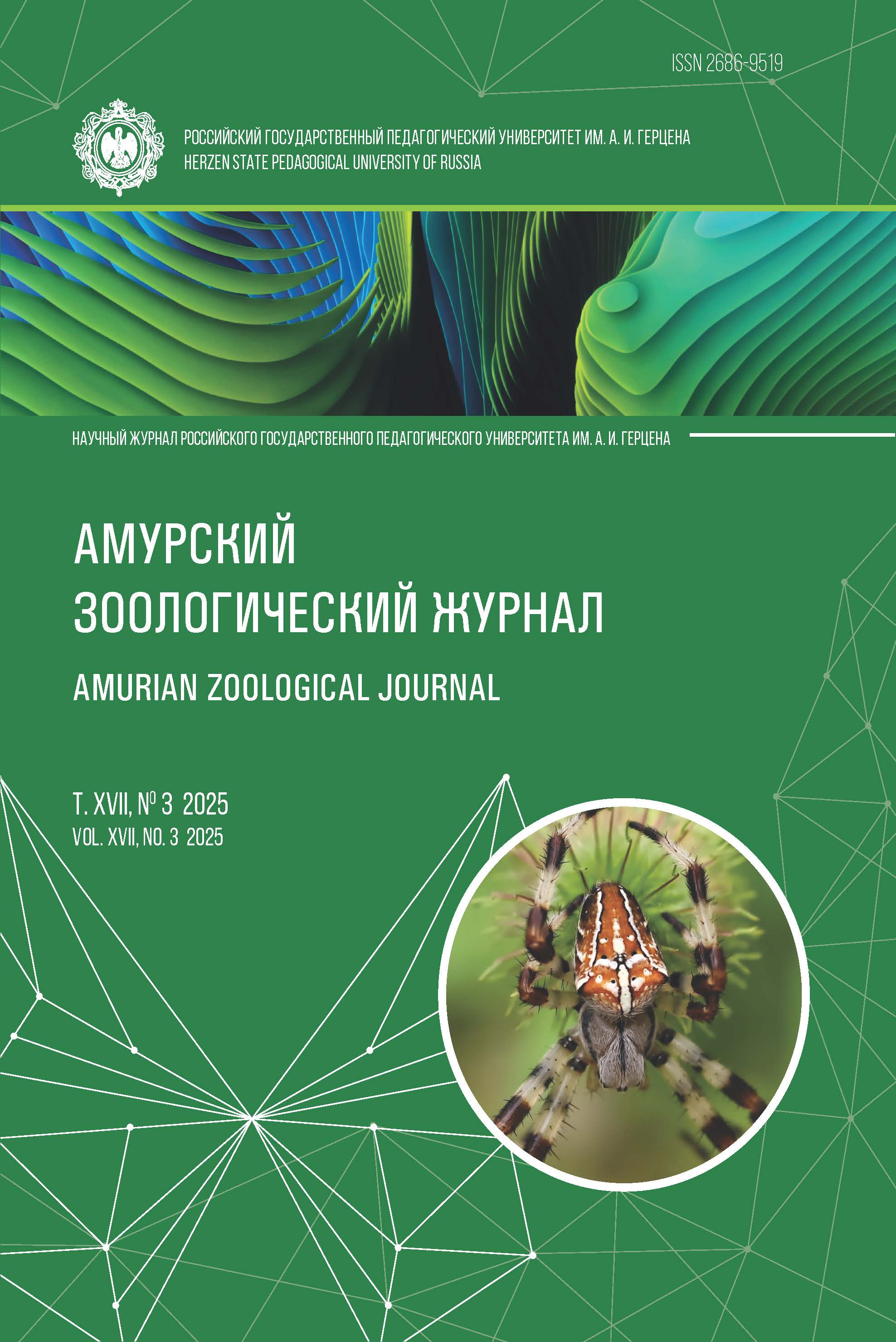The millipede Unciger foetidus (C.L. Koch, 1838) in the Kaluga Region: Distribution and habitats (Diplopoda: Julida: Julidae)
DOI:
https://doi.org/10.33910/2686-9519-2025-17-3-442-448Keywords:
Diplopoda, distribution, synanthropic species, the East European Plain, the Oka River, broadleaved forest, gardenAbstract
The millipede Unciger foetidus is synanthropic in the northern parts of its range and is introduced to some regions. For Central Russia it has not been previously listed. In the Kaluga Region (European Russia) it was found along the Oka River from Kaluga to Tarusa and in urban settlements Kaluga, Kondrovo, and Tarusa and their nearby surroundings. It inhabits gardens, former quarries, as well as broadleaved, birch, aspen, willow-alder, willow, boxelder, and pine forests. It has a high abundance in forests in the Oka River valley and in gardens.
References
Chornyi, N. G., Golovatch, S. I. (1993) Dvuparnonogie mnogonozhki ravninnykh territorij Ukrainy [Millipedes of the Ukraine’s plain territories]. Kiev: Kiev University Publ., 58 p. (In Russian)
Golovatch, S. I. (2021) Novye nakhodki diplopod (Diplopoda) iz evropejskoj Rossii i Abkhazii (Kavkaz) [New records of millipedes (Diplopoda) from European Russia and Abkhazia, Caucasus]. Zoologiya bespozvonochnykh — Invertebrate Zoology, vol. 18, no. 2, pp. 80–84. https://doi.org/10.15298/invertzool.18.2.02 (In English)
Golovatch, S. I., Kime, R. D. (2009) Millipede (Diplopoda) distributions: A review. Soil Organisms, vol. 81, no. 3, pp. 565–597. (In English)
Gongalsky, K. B., Kuznetsova, D. M., Filimonova, Zh. V., Shakhab, S. V. (2013) Rasprostranenie i ekologiya invazivnogo vida mokrits Hyloniscus riparius (C. Koch, 1838) (Isopoda, Oniscidea, Trichoniscidae) v Rossii [Distribution and ecology of the invasive species of woodlice Hyloniscus riparius (C. Koch, 1838) (Isopoda, Oniscidea, Trichoniscidae) in Russia]. Rossijskij zhurnal biologicheskikh invazij — Russian Journal of Biological Invasions, vol. 4, no. 2, pp. 116–119. https://doi.org/10.1134/S2075111713020045 (In English)
Hulme, P. E., Bacher, S., Kenis, M. et al. (2008) Grasping at the routes of biological invasions: A framework for integrating pathways into policy. Journal of Applied Ecology, vol. 45, no. 2, pp. 403–414. https://doi.org/10.1111/j.1365-2664.2007.01442.x (In English)
Jones, R. E. (1985) Unciger foetidus, a millipede new to Britain from Norfolk. Transactions of the Norfolk and Norwich Naturalists’ Society, vol. 27, no. 1, pp. 63–65. (In English)
Kime, R. D. (1999) The continental distribution of British and Irish millipedes. Bulletin of the British Myriapod Group, vol. 15, pp. 33–76. (In English)
Kime, R. D., Enghoff, H. (2017) Atlas of European millipedes 2: Order Julida (Class Diplopoda). European Journal of Taxonomy, vol. 346, pp. 1–299. https://doi.org/10.5852/ejt.2017.346 (In English)
Lokshina, I. E. (1969) Opredelitel’ dvuparnonogikh mnogonozhek Diplopoda ravninnoj chasti Evropejskoj territorii SSSR [Identification book of the millipedes (Diplopoda) in the plain parts of the USSR European territory]. Moscow: Nauka Publ., 78 p. (In Russian)
Nefediev, P. S., Nefedieva, J. S., Dyachkov, Yu. V. (2014) Obzor antropokhornoj diplopodofauny aziatskoj chasti Rossii s novymi nakhodkami iz Altajskogo kraya, Sibir’ (Diplopoda) [A review of the anthropochore millipede fauna of Asian Russia, with new records from the Altai Province, Siberia (Diplopoda)]. Russkij artropodologicheskij zhurnal — Arthropoda Selecta, vol. 23, no. 4, pp. 337–345. https://doi.org/10.15298/arthsel.23.4.02 (In English)
Roderick, G. K., Navajas, M. (2015) Invasions of terrestrial arthropods: Mechanisms, pathways, and dynamics. In: J. Canning-Clode (ed.). Biological invasions in changing ecosystems: Vectors, ecological impacts, management and predictions. Warsaw: De Gruyter Open Publ., pp. 75–87. https://doi.org/10.1515/9783110438666-008 (In English)
Roy, H., Rorke, S., Wong, L. J., Pagad, S. (2020) Global Register of Introduced and Invasive Species — Great Britain. Version 1.7. Invasive Species Specialist Group ISSG. [Online]. Available at: https://doi.org/10.15468/8rzqvw (accessed 19.05.2025). (In English)
Semenyuk, I. I., Tiunov, A. V. (2011) Skhodstvo troficheskikh nish diplopod (Myriapoda, Diplopoda) v shirokolistvennom lesu podtverzhdaetsya izotopnym analizom (15N/14N i 13C/12C) [Isotopic signature (15N/14N and 13C/12C) confirms similarity of trophic niches of millipedes (Myriapoda, Diplopoda) in a temperate deciduous forest]. Izvestiya Rossijskoj akademii nauk. Seriya Biologicheskaya — Biology Bulletin, vol. 38, no. 3, pp. 283–291. https://doi.org/10.1134/S1062359011030137 (In English)
Thomas, C. D. (2010) Climate, climate change and range boundaries. Diversity and Distributions, vol. 16, no. 3, pp. 488–495. https://doi.org/10.1111/j.1472-4642.2010.00642.x (In English)
Turin, H., Penev, L., Casale, A. (eds.). (2003) The genus Carabus in Europe: A synthesis. Sofia; Moscow; Leiden: Pensoft Publ.; European Invertebrate Survey Publ., 511 p. (In English)
Wytwer, J., Golovatch, S. I., Penev, L. (2009) Variation in millipede (Diplopoda) assemblages in oak woodlands of the Eastern European Plain. Soil Organisms, vol. 81, no. 3, pp. 791–813. (In English)
Zalesskaja, N. T., Titova, L. P., Golovatch, S. I. (1982) Fauna mnogonozhek (Myriapoda) Podmoskov’ya [The myriapod fauna (Myriapoda) of Moscow Region]. In: M. S. Ghilarov (ed.). Pochvennye bespozvonochnye Moskovskoj oblasti [Soil invertebrates of Moscow Region]. Moscow: Nauka Publ., pp. 179–200. (In Russian)
Downloads
Published
Issue
Section
License
Copyright (c) 2025 Victor V. Aleksanov

This work is licensed under a Creative Commons Attribution-NonCommercial 4.0 International License.
The work is provided under the terms of the Public Offer and of Creative Commons public license Attribution-NonCommercial 4.0 International (CC BY-NC 4.0). This license allows an unlimited number of persons to reproduce and share the Licensed Material in all media and formats. Any use of the Licensed Material shall contain an identification of its Creator(s) and must be for non-commercial purposes only.







